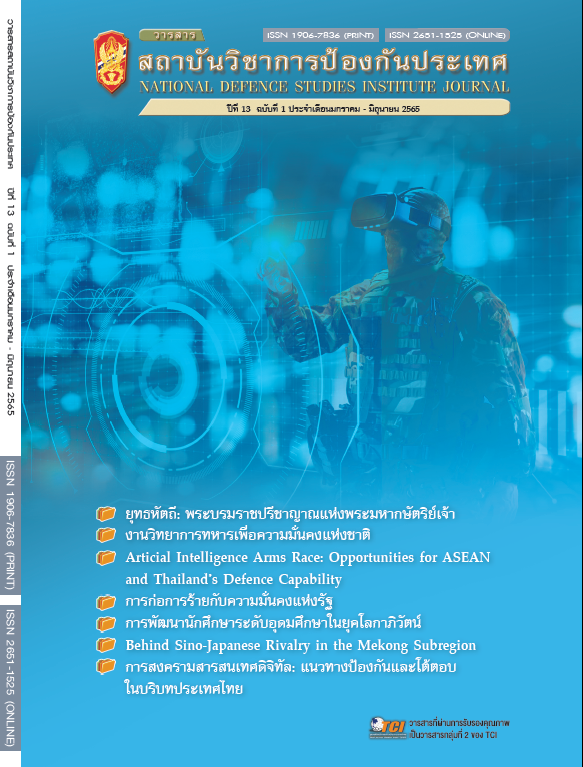Behind Sino-Japanese Rivalry in the Mekong Subregion
Main Article Content
Abstract
This research has two main objectives: 1) to identify the causal factors of Sino-Japanese rivalry in the Mekong subregion and 2) to analyze the evolution and aspects of Sino-Japanese rivalry in the Mekong. As the analytical tool, this paper applied the power-based approach-realism and power transition theories. This study is qualitative research, which relies on both primary and secondary sources. The information derived from the semi-structured interview will only be used as a supplement.
The study reveals that the power shift between China and Japan is the principal cause that spurs rivalry between the two Asian powers whereas conflicting interests between the rivals add negative energy into the chain of actions and reactions and thus sustain their rivalry. Areas of overlapping interests between the two countries appear in the realms of strategic importance, geopolitics, and economy in the case of the Mekong subregion.
Article Details

This work is licensed under a Creative Commons Attribution-NonCommercial-NoDerivatives 4.0 International License.
The articles, images, tables, graphs, written content, and opinions published in this journal are solely those of the authors and do not necessarily reflect the views or positions of the National Defence Studies Institute or its academic affiliates.
References
Aizawa, M. (2019). Can a Japan-China rivalry drive high-speed rail sustainability? East Asia Forum. Retrieved from https://www.eastasiaforum.org/2019/08/03/can-a-japan-china-rivalry-drive-highspeed-rail-sustainability/
Anti-Japan mood fosters Chinese unity. (1996, September 18). CNN. Retrieved from http://edition.cnn.com/WORLD/9609/18/island.dispute/index.html
Asian Development Bank [ADB]. (2017). Meeting Asia’s infrastructure needs. Retrieved from https://www.adb.org/sites/default/files/publication/227496/special-report-infrastructure.pdf
Bendini, R. (2014). The struggle for control of the East China Sea (PE 536.398.). Retrieved December 12, 2021 from https://www.europarl.europa.eu/RegData/etudes/IDAN/2014/536398/EXPO_IDA (2014) 536398_EN.pdf
Biba, S. (2019). China’s hegemonic choice in the Mekong region. East Asia Forum. Retrieved June 8, 2021 from https://www.eastasiaforum.org/2019/08/30/chinas-hegemonic-choice-in-the-mekong-region/
Bush, R. C. (2010). The perils of proximity: China-Japan security relations. Washington D.C.: Brookings Institution Press.
Choucri, N., and North, R. C. (1975). Nations in conflict: National growth and international violence.San Francisco: W.H. Freeman.
EEC. (2021, March 7). The 1/2021 meeting of the Policy Committee of the Eastern Economic Corridor (EEC) Special Development Zone. Retrieved January 16, 2022 from https://www.eeco.or.th/en/news-release-pr/The-1-2021-meeting-of-the-Policy-Committee-of-the-Eastern-Economic-Corridor-EEC-Special-Development-Zone
Gilpin, R. (1981). War and change in world politics. Cambridge: Cambridge University Press.
He, Y. (2007). Remembering and forgetting the war: Elite mythmaking, mass reaction, and Sino-Japanese relations, 1950-2006. History & Memory, 19(2), 43-74.
IPDForum. (2019, November 11). Money for the Mekong. Indo-Pacific Defense Forum. Retrieved August 18, 2020 from https://ipdefenseforum.com/2019/11/money-for-the-mekong
Jiangyong, L. (2018). What now for Japan and China?. East Asia Forum. Retrieved January 16, 2022 from https://www.eastasiaforum.org/2018/11/08/what-now-for-japan-and-china/
Kikuchi, T. and Zi, W. (2016, November 23). The AIIB and shifting economic dynamics in Southeast Asia. Brink. Retrieved from December 14, 2021 from https://www.brinknews.com/the-aiib-and-shiftingeconomic-dynamics-in-southeast-asia/
Koga, K. (2020). Japan’s ‘Indo-Pacific’ question: Countering China or shaping a new regional order? International Affairs, 96(1), 49-73.
Kraisoraphong, K. (2017). China, Japan, and the greater Mekong basin: A Southeast Asian perspective.In L. Peng Er (ed.), China-Japan Relations in the 21st Century: Antagonism Despite Interdependency (p.158-183). Singapore: Palgrave Macmillan.
Lentz, C. (2018, November 21). Japan’s foreign policy in the Mekong region: Geoeconomics in action in Southeast Asia. Diplomat. Retrieved December 14, 2021 from https://thediplomat.com/ 2018/11/japans-foreign-policy-in-the-mekong-region/
Lintner, B. (2018, October 18). Japan offers ‘Quality’ alternative to China’s BRI. Asia Times. Retrieved June 22, 2021 from https://asiatimes.com/2018/10/japan-offers-quality-alternative-to-chinas-bri/
Makino, C. (2009, November 11). Japan: Fresh aid to Mekong signals rivalry with China-experts. Inter Press Service. Retrieved September 17, 2019 from http://www.ipsnews.net/2009/11/japan-fresh-aid-to-mekong-signals-rivalry-with-china-experts/
Male Professor, Temple University. (October 30, 2021). Interview.
Ministry of foreign Affairs [MOFA]. (2019). The Mekong-Japan initiative for SDGs toward 2030. Retrieved August 18, 2020 from https://www.mofa.go.jp/files/000535957.pdf
Ogasawara, T. (2015). Development of the Mekong Region as part of Japan’s diplomatic strategy for East Asia. Asia-Pacific Review, 22(1), 34-45.
Prasad, R. (2018, May 18). The China-Japan infrastructure nexus: Competition or collaboration?. Diplomat. Retrieved December 16, 2021 from https://thediplomat.com/2018/05/the-chinajapan- infrastructure-nexus-competition-or-collaboration/
Seneviratne, K. (2018, October 9). Sino-Japan rivalry intensifies in Asia’s new growth region. WION. Retrieved August 6, 2020, from https://www.wionews.com/opinions/sino-japan-rivalry-intensifiesin-asias-growth-region-170357
Song, Y., Qiao-Franco, G., & Liu, T. (2021). Becoming a normative power? China’s Mekong agenda in the era of Xi Jinping. International Affairs, 97(6), 1709-1726.
Theparat, C. (2019, May 7). China, Japan to join EEC smart city plan. Bangkok Post. Retrieved January 16, 2022 from https://www.bangkokpost.com/business/1673272/china-japan-to-join-eecsmart-city-plan
Thompson, W. R. (Ed.). (1999). Great power rivalries. Columbia, SC: University of South Carolina.
Vannarith, C. (2010). CICP working paper no. 34 An introduction for Greater Mekong Subregional cooperation. Retrieved August 6, 2020, from https://cicp.org.kh/wp-content/uploads/2021/02/CICP-Working-Paper-No-34_An-Introduction-to-Greater-Mekong-Subregional-Cooperation.pdf
Welfield, J. (2013). An empire in eclipse: Japan in the postwar American alliance system, a study in the interaction of domestic politics and foreign policy. London: Bloomsbury.
Wilkins, T. (2021). Japan as a contributor to the rules-based order in the Indo-Pacific. Retrieved December 16, 2021 from https://www.spf.org/iina/en/articles/thomas_02.html
Xinhua. (2018, November 1). China pledges another 6 bln USD loans for Lancang-Mekong cooperation.China Daily. Retrieved December 12, 2021 from http://www.chinadaily.com.cn/a/201801/11/WS5a576835a3102c394518e9f2.html
Xinhua. (2006, December 29). China starts shipping oil via Mekong River. China.org.cn. Retrieved December 16, 2021 from http://www.china.org.cn/english/MATERIAL/194278.htm
Yi, L. (2013, July 5). China-Myanmar oil and gas pipelines: a $5 billion problem. China Dialogue.Retrieved December 16, 2021 from https://chinadialogue.net/en/energy/6183-china-myanmar-oiland- gas-pipelines-a-5-billion-problem/
Yoshimatsu, H. (2010). The Mekong region, regional integration, and political rivalry among ASEAN, China, and Japan. Asian Perspective, 34(3), 71-111.
Zakaria, F. (1998). From wealth to power: The unusual origins of America’s world role. Princeton, N.J.: Princeton University Press.
Zhao, H. (2018). China-Japan competes for infrastructure investment in Southeast Asia: Geopolitica rivalry or healthy competition?. Journal of Contemporary China, 28(118), 558-574.


